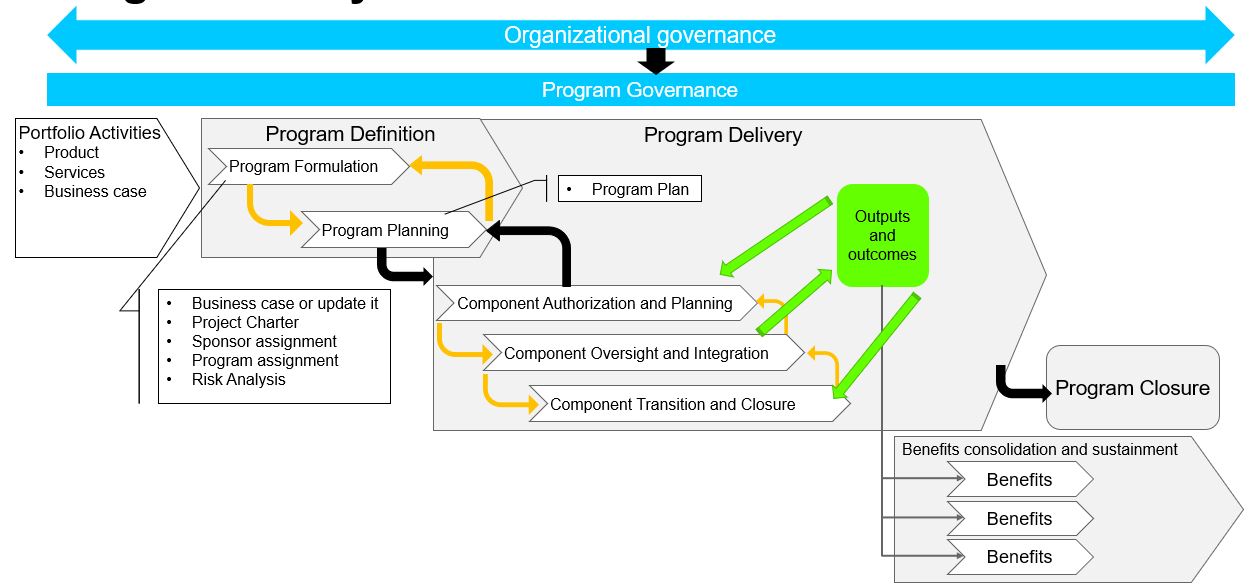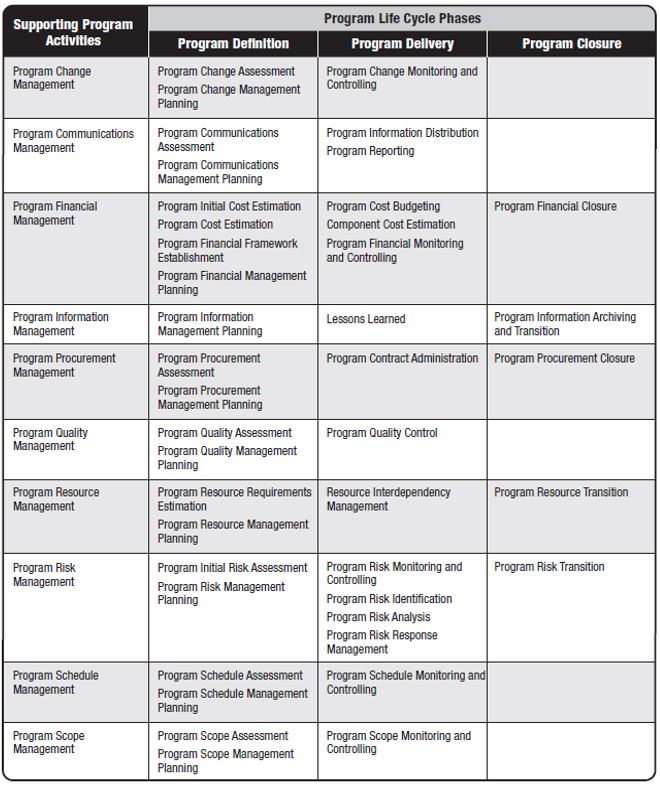Program Life Cycle Management performance domain facilitates effective program definition, program delivery, and program closure.
These components may include projects, subsidiary programs, and additional program-related activities that are necessary to achieve the specified goals and objectives.
Since programs, by nature, involve a certain level of uncertainty, change, complexity, and inter-dependency among the various components, it is useful to establish a common and consistent set of processes that can be applied across phases.
Program Life Cycle Management spans the duration of the program, during which it contributes to and integrates with the other program domains as well as the supporting program activities.
1.- The program life cycle
- A program is defined, benefits are delivered, and the program is closed.
- The programs involve the coordination and sequencing of multiple components above what is required at an individual project level.
- The program activities begin before funding in approved.
- During program delivery, components are authorized, planned, and executed, and benefits are delivered.
- Program closure is then approved by the program steering committee when the desired benefits or program objectives have been realized or the steering committee has determined that the program should be terminated.
The program life cycle phases overview
- Program Definition Phase. This phase consists of program activities conducted to authorize the program and develop the program roadmap required to achieve the expected results.
- Program Delivery Phase. Program delivery comprises the program activities performed to produce the intended results of each component in accordance with the program management plan.
- Program Closure Phase. This phase includes the program activities necessary to transition the program benefits to the sustaining organization and formally close the program in a controlled manner.
During program closure, the program is transitioned and closed or terminated early, or work is transitioned to another program.
 Program Definition phase
Program Definition phase
The program definition phase includes program activities conducted to authorize the program and develop the program roadmap required to achieve the expected results
There may be a number of activities executed by a portfolio management body prior to the start of the program definition phase.
The primary purpose of the program definition phase is to progressively elaborate the goals and objectives to be addressed by the program, define the expected program outcomes and benefits, and seek approval for the program.
Program formulation includes:
- Initiate studies and estimates of scope, resources, and cost;
- Develop an initial risk assessment; and
- Develop a program charter and roadmap.
The candidate program is compared with other organizational initiatives to determine the priority of the program under consideration.
This analysis helps determine the probability of the program’s successful delivery of organizational benefits and helps identify risk response strategies and plans.
The contents of the program charter generally consist of the following questions and their answers:
- Justification. Why is the program important and what does it achieve?
- Vision. What is the end state and how will it benefit the organization?
- Strategic alignment. What are the key strategic drivers and the program’s relationship to the organizational strategic objectives and any other ongoing strategic initiatives.
- Benefits. What are the key outcomes required to achieve the program vision and benefits?
- Scope. What is included within the program and what is considered to be out of scope at a high level?
- Components. How are the projects and other program components configured to deliver the program and the intended benefits?
- Risks and issues. What are the initial risks and issues identified during the preparation of the program roadmap?
- Timeline. What is the total length of the program, including all key milestone dates?
- Stakeholder considerations. Who are the key stakeholders, who are the most important stakeholders,
- Program governance. What is the recommended governance structure to manage, control, and support the program?
Program Planning, commences upon formal approval of the program charter by the program steering committee. This plan is the key output created during program planning and may be combined into one plan or multiple plans that include the following subsidiary documents:
- Benefits management plan
- Stakeholder engagement plan
- Governance plan
- Change management plan
- Communications management plan
- Financial management plan
- Information management plan
- Procurement management plan
- Quality management plan
- Resource management plan
- Risk management plan
- Schedule management plan
- Scope management plan
- Program roadmap
Program delivery phase includes program activities performed to produce the intended results of each component in accordance with the program management plan.
The program manager is also responsible for managing this group of components in a consistent and coordinated way in order to achieve results that could not be obtained by managing the components as stand-alone efforts.
Each program component will progress through the following program delivery sub-phases:
- Component authorization and planning: involves the initiation of components based on the organization’s specified criteria and individual business cases developed for each component. These criteria are generally included in the program governance plan. The Program Governance Performance Domain provides guidance for processes leading to component authorization.
- Component oversight and integration. In the context of a program, some components may produce benefits as individual components, while other components are integrated with others before the associated benefits may be realized. Each component team executes its associated plans and program integrative work. Throughout this activity, components provide status and other information to the program manager and to their associated components so their efforts may be integrated into and coordinated with the overall program activities
- Component transition and closure. After the program components have produced deliverables and coordinated the successful delivery of their products, services, or results, these components are typically scheduled for closure or transition to operations or ongoing work. Prior to the end of the program delivery phase, all component areas are reviewed to verify that the benefits were delivered and to transition any remaining projects and sustaining activities.
Program delivery ends when program governance determines that the specific criteria for this phase have been satisfied or a decision is made to terminate the program.
Program closure phase includes program activities necessary to transition program benefits to the sustaining organization and formally close the program in a controlled manner.
During program transition, the program steering committee is consulted to determine whether:
- (a) the program has met all of the desired benefits and that all transition work has been performed within the component transition, or
- (b) there is another program or sustaining activity that will oversee the ongoing benefits for which this program was chartered.
2.- Program activities and Integration Management
Program activities and integration management are concerned with collectively utilizing the resources, knowledge, and skills available to effectively deploy multiple components throughout the program life cycle.
This process also involves making decisions regarding:
- Competing demands and priorities,
- Risks,
- Resource allocations,
- Changes due to uncertainty and complexity of the program scope,
- Inter-dependencies among components, and
- Coordination of work to meet the program objectives
Program activities overview
All work performed in a program for the purpose of overall program management is collectively known as program activities.
It is important to note that program activities directly support the individual components to ensure the component activities help achieve the program objectives.
Program integration management
is the core activity that occurs across the entire program life cycle.
This section focuses on the following activities and when they are performed throughout the program life cycle phases:
- a) Program infrastructure development
- b) Program delivery management
- c) Program performance monitoring and controlling
- d) Benefits sustainment and program transition
- e) Program closeout
a) Program infrastructure development its primary purpose is twofold. It establishes both the management and technical resources of the program and its components. This infrastructure refers to both personnel and to program specific tools, facilities, and finances used to manage the program.
Although the program manager is assigned during program definition, the program management core team is designated as part of establishing the program infrastructure.
For many programs, the program management office (PMO) is a core part of the program infrastructure. It supports the management and coordination of the program and component work.
An effective PMIS incorporates:
- Software tools;
- Documents, data, and knowledge repositories;
- Configuration management tools;
- Change management system;
- Risk database and analysis tools;
- Financial management systems;
- Earned value management activities and tools;
- Requirements management activities and tools; and
- Other tools and activities as required.
These resources are separate and distinct from the resources required to manage the individual components within the program
b) Program delivery management includes the management, oversight, integration, and optimization of the program components that will deliver the capabilities and benefits required for the organization to realize value.
These activities are performed throughout the program delivery phase and relate to the initiation, change, transition, and closure of program components.
During the course of program delivery, change requests that fall within the program manager’s authority level will be approved or rejected to manage performance and any changes to the program management plan
c) Program performance monitoring and controlling are performed by both program- and project-level components during delivery management.
- These activities include collecting, measuring, and disseminating performance information to track progress against the program objectives and assess overall program trends.
- Typical outputs of this ongoing activity include program performance reports and forecasts. Program performance reports include a summary of the progress of all program components.
d) Benefits sustainment and program transition. Some program components produce immediate benefits while others require a hand-off or transition to another organization in order for the ongoing benefit to be realized.
Benefits sustainment may be achieved through operations, maintenance, new projects, or other initiatives and efforts.
This activity transcends the scope of individual program components since this work is typically performed as the program is closed
e) Program closeout. As part of the program governance plan, a final program report may be required to document critical information that can be applied to improve the success of future programs and component projects.
This final report may consist of:
- Financial and performance assessments,
- Lessons learned,
- Successes and failures,
- Identified areas for improvement,
- Risk management outcomes,
- Unforeseen risks,
- Customer sign-off,
- Reason(s) for program closeout,
- History of all baselines, and
- Archive plan for program documentation.
Upon program completion, knowledge transfer is performed when the program management team assesses the program’s performance and shares lessons learned with the organization.
Mapping of the program management life cycle to program activities
If you found this post interesting, maybe you will find other program management posts that are useful too. Many thanks for visiting.

The article is excellent and very educative and hugely helped me in my job.
Thank you for sharing.